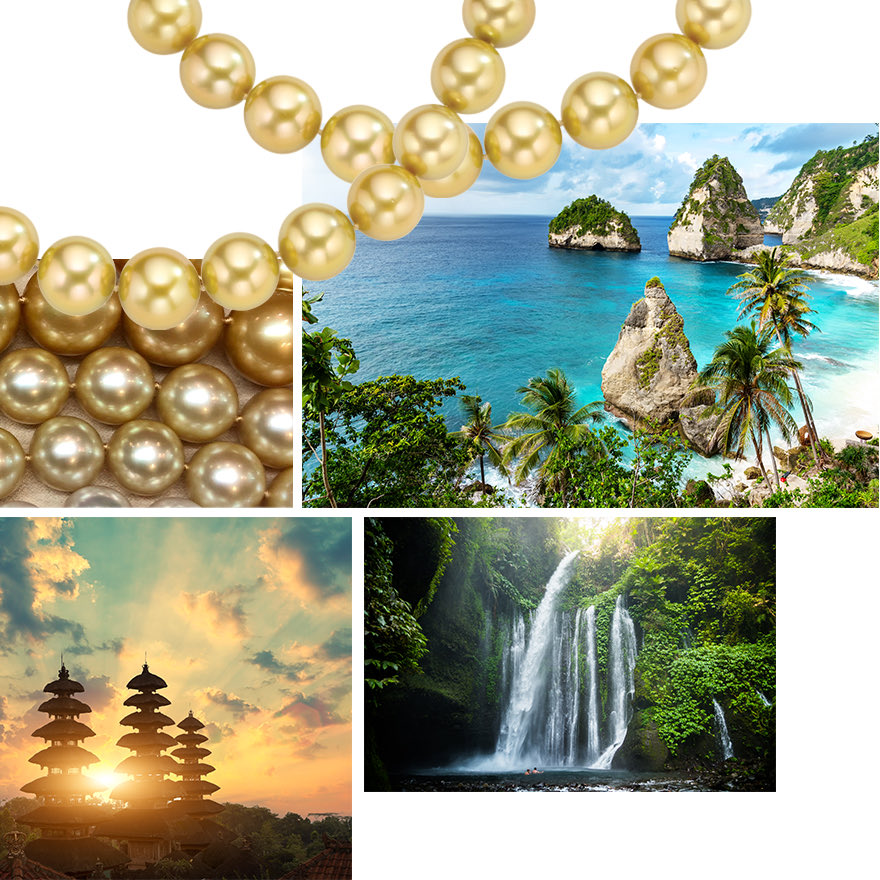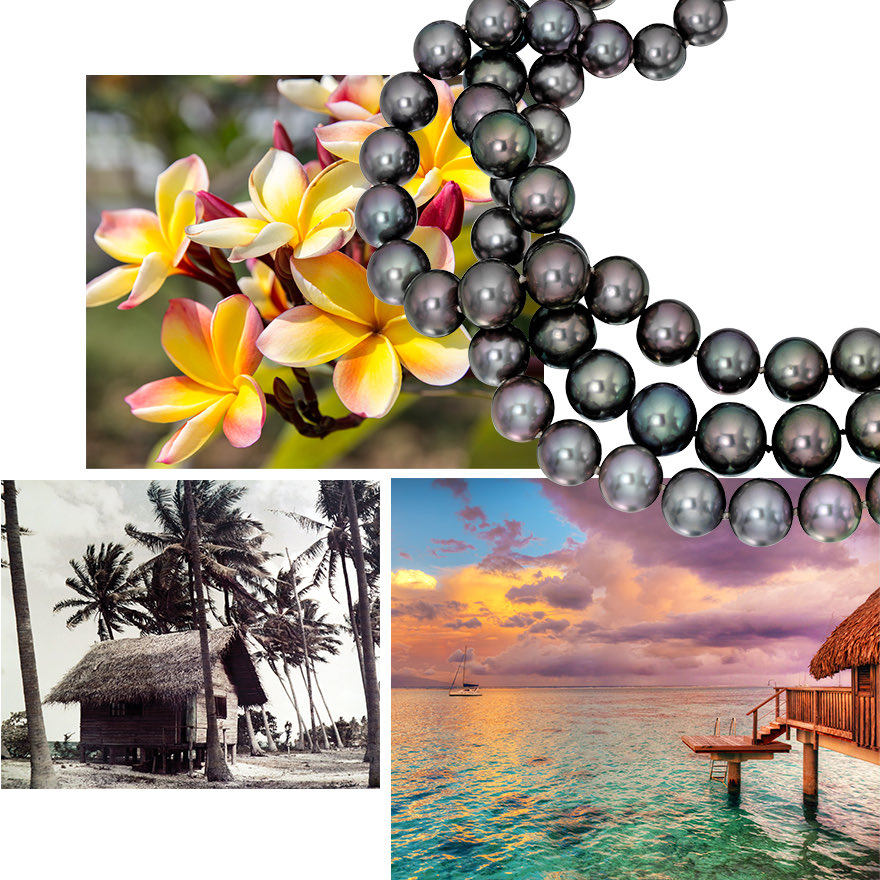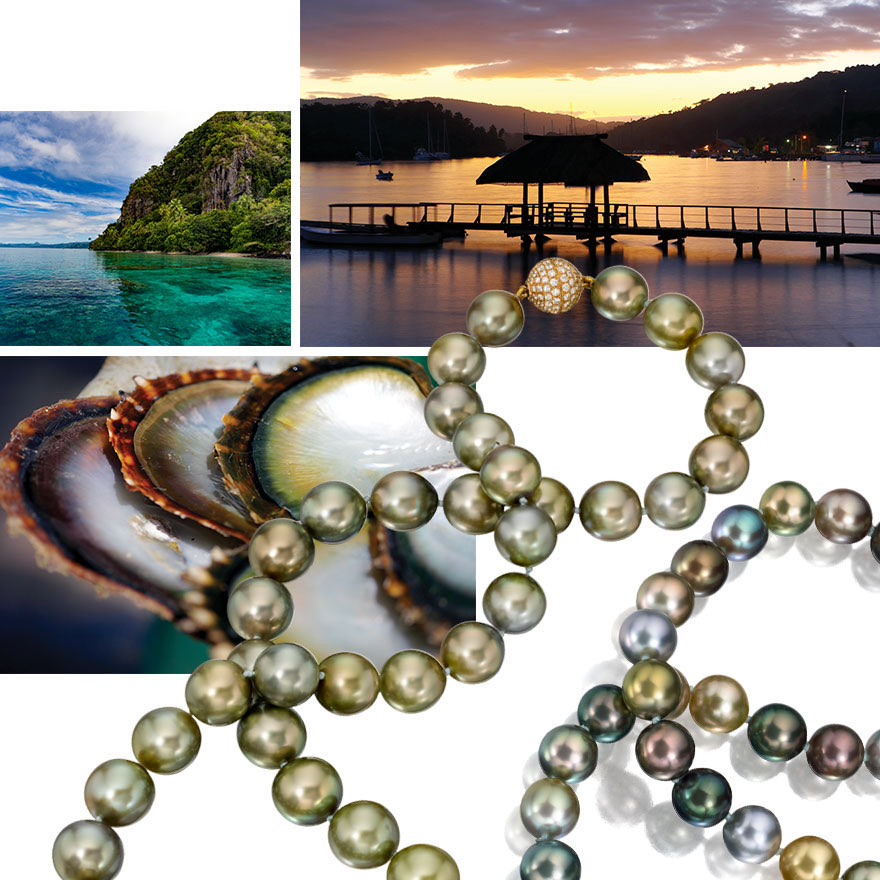
A Global Guide to South Sea Pearls
Do you know how you can tell where a pearl is from? The answer is simpler than you might expect. The color of a pearl will match the Mother of Pearl lip, the inside rim of the oyster that the pearl grew in. That ‘lip’ color is determined by the genus of the oyster. Different species of oysters grow and thrive in different parts of the world. Unlike human beings, oysters do not pack up and move to different ecosystems. Because unique species of oysters live in certain areas of the globe, you can often tell where a pearl is from simply by its color.
The origins of South Sea cultured pearls are almost as exotic and colorful as the pearls themselves. They come in a wide variety of types and colors from many places in the Southern Hemisphere around the globe. Join us, from the comfort of home, on a global tour of pearls, featuring the most exclusive South Sea Pearl Types and the beautiful locations where they are cultivated and grown organically in the local oysters of our planet’s oceans, bays and seas.
SOUTH SEA PEARLS – Australia and the “South Seas”

Clockwise from upper left – a Paspaley pearl diver collecting wild oysters, photo courtesy of Paspaley / Crab Creek in Broome, Australia ‘where the red dirt meets the sea’ / Paspaley pearl farm near NSW Australia, photo courtesy of Paspaley / Assael South Sea Pearl strand / View from Five Rivers Lookout Western Australia, Assael South Sea Single Pearls
The term “South Seas” commonly refers to areas of the globe south of 10° north latitude, including the South Pacific Ocean, the Indian Ocean, the Timor Sea and the Arafura Sea. Considered the most exclusive and coveted of all cultured pearl varieties, South Sea Pearls include both South Sea White Pearls and South Sea Golden Pearls. Assael’s South Sea White Cultured Pearls are known for their extraordinary size and satiny luster, and they originate in Australia. The Assael family has long-standing relationships with leading pearl farmers in the northwestern region of Australia known as The Kimberley, bordered on the west by the Indian Ocean and on the north by the Timor Sea. The city of Broome, “where the red sand meets the sea,” is home to several Australian pearl farmers. The remote and particularly challenging natural environment has not deterred fearless pearl farmers from cultivating pearls in this area since the 1950s.
The large oyster species known as Pinctada Maxima thrives off the coast of The Kimberley. Only the Australian South Sea Pearl comes from this large oyster, and it varies in color from white-pink to white-silver and even pure white. This sizable species produces much larger cultured pearls of exquisite quality, with pearls measuring up to 20-21mm, but those extremely large sizes are now very rare. The pearls from the area have exceptional luster and extremely smooth complexions, along with the colors mentioned above – all the hallmarks of ultimate pearl quality. The clearer the reflection on the surface of the pearl, the higher the pearl’s luster. And the better quality, the rarer the pearl. For these reasons, Australian South Sea pearls are highly prized and sought after. Thanks to company founder Salvador Assael’s long-term relationship with preeminent pearl farmers in the area, the Assael brand enjoys first selection when the new pearls are harvested each year.
GOLDEN SOUTH SEA PEARLS – Indonesia & The Philippines

Clockwise from upper left – Assael Golden South Sea Pearl Strands / Diamond Beach, Nusa Penida Beach in Bali / National Park in Lombok Island Indonesia / Bali Temple in Indonesia / Assael South Sea Golden Pearls
Golden South Sea Pearls come from the Celebes Sea between Indonesia and The Philippines. The medium-sized ‘gold-lipped’ Pinctada Maxima oysters native to this particular habitat have a golden mother-of-pearl lip on their shell. When this oyster secretes its epithelial cells to form the precious nacre of the pearl, the result is a golden pearl. (For more information on how pearls are formed, click here.) Golden South Sea Pearls come in shades from pale to pink gold to green gold to intense gold. Some of the most pristine and undeveloped sections of the world, like the Palawan province in the southern Philippines, develop some of the highest quality pearls. Assael’s Golden South Sea Pearls are prized for their deep golden hue, as well as their size and smoothness. Golden Pearls make a wonderful addition to a pearl lover’s collection, offering variety as well as white and gold pearl layering options, bringing a touch of sophistication to even the most elegant wardrobes.
TAHITIAN PEARLS – French Polynesia and Tahiti

Clockwise from upper left – White and Pink Frangipani tropical flowers from French Polynesia / Assael Tahitian Pearl Strands / Overwater Bungalo in Moorea, French Polynesia / Salvador Assael’s first bungalow in Tahiti
Tahitian pearls, as per their name, come from the seas surrounding Tahiti. The medium sized Pinctada Margaritifera oyster lives in the waters of French Polynesia. This ‘black-lipped’ oyster naturally secretes darker epithelial cells to form pearls in a myriad of shades, ranging from charcoal gray and black to olive green and magenta. The beautiful deep hues of Tahitian pearls are primarily known to us in North American thanks to the work of the late Salvador Assael. In the 1970s, partnering with a local friend on the atoll of Marutea in Tahiti, Salvador Assael utilized his life-long pearl expertise to create, launch and develop pearl farms there that produced incredibly beautiful Tahitian pearls. Salvador even brought over Japanese pearl experts to finesse the pearl cultivation process, ensuring the absolute highest quality of the pearls. When he shared the first handful of carefully matched strands with Harry Winston in 1978, Winston was smitten. He sold the entire first collection and requested more, prompting headlines like “A New Gem is Born!” Salvador split much of his time between New York and Tahiti in those years, developing and supporting the entire industry. Those Tahitian Pearls were so incredible and innovative at the time that the press dubbed Salvador “The Pearl King.” To this day, the Assael brand continues to cherish long-standing relationships with pearl farmers in Tahiti and French Polynesia, giving the brand first dibs on the very finest pearls produced with every harvest.
FIJI PEARLS – A Rainbow of Colors

Clockwise from upper left – pristine waters of the Savu Savu Bay in Fiji / dock at sunset in Fiji / 18” Multicolor Sustainable Fiji Pearl Necklace by J. Hunter for Assael / “18.25” Sustainable Fiji Pearl Necklace by J. Hunter for Assael / Various Colorfully Lipped Oyster Shells from Fiji, images courtesy of J. Hunter Fiji Pearls
Nestled in the heart of the SavuSavu Bay of the Fiji Islands in the South Pacific Ocean, the J. Hunter Pearl farms are producing a rainbow array of pearl colors – from pistachio green to cranberry, sapphire, chocolate, silver, gold and more. The Pinctada Margaritifera-Typica oyster, a subspecies of the black-lipped Tahitian oyster, is native to the Koro Sea that circles Fiji Islands. It is a rare and distinctive medium-sized oyster characterized by its earth-toned shell exterior, its wide spectrum of both warm and cool hued mother-of-pearl in the shells, as well as its bright orange body. This oyster is especially difficult to source and even more challenging to farm, making its precious pearl crops very valuable. Assael is proud to be the exclusive US distributor for J. Hunter Fiji pearls, offering new and never-before-seen hues of pearls to South Sea Pearl fans everywhere. The vibrancy of color in these exotic pearls creates luminous overtones that make them shine with a radiance and sheen mimicking precious metals. That quality, combined with relatively small quantities and the admirable ocean conservation efforts pursued by the local Fiji pearl farmers, make these responsibly sourced natural-color pearls a huge prize for pearl connoisseurs. To see some beautiful examples of Fiji pearl jewelry from Assael, click here.
OTHER PEARL TYPES – Akoya, Non-Nacreous, Keshi, Baroque
South Sea Pearls are not the only high-quality pearls available to pearl lovers. More fabulous pearl types come from other places in the world. Highly Lustrous Akoya Pearls come from the white Pinctada Fucata oysters of Japan. To read more about Akoya Pearls, click here. Pretty pink Conch Pearls come from the Caribbean. And the extremely rare Melo Melo Pearls come from places in Southeast Asia like Vietnam and Burma. Stay tuned for more on the Conch and Melo-Melo non-nacreous pearl varieties.
The term Baroque Pearls is used to refer to the shape of pearls that are non-round. And Keshi Pearls are a natural by-product of cultivation with no nucleus and wonderful organic shapes. Almost all of the types of pearl mentioned above can be baroque (meaning non-round) or keshi (meaning non-nucleated, organic in shape, forming as a by-product of the cultivation process). Visit Assael.com to explore all of these types of pearls, as well as a vast assortment of beautiful jewelry designs made with these pearls. And be sure to visit the blog often for more pearl trends and more educational information on pearls.
If you liked this post, you might also like:
https://assael.com/blog/behind-scenes-our-latest-pearl-quest/
https://assael.com/blog/pearl-shopping-101-6-things-to-consider-when-buying-pearls/
https://assael.com/blog/large-luxurious-south-sea-cultured-pearls/
https://assael.com/blog/stewards-of-the-sea-how-modern-pearl-farmers-are-protecting-the-ocean/
Posted on Apr 21, 2020 in Pearl Education, Trends by Duvall O'Steen
Articles you may also enjoy
Join our Mailing List
Join us for magnificent pearl trends and exclusive treasures. Discover a world that is truly ... beyond rare.

Feeling inspired?
Consider this your invitation to the House of Assael. Find your closest luxury jeweler using our map search and start your journey to timeless elegance.




